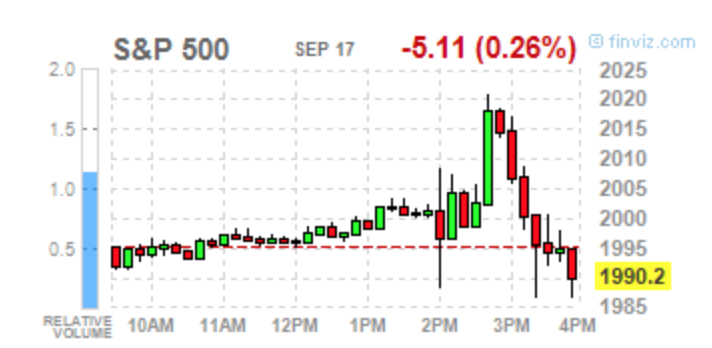Now What?
After the Fed’s decision.
*****
A few weeks ago I made the point the Chinese market turmoil hinted at a loss of effectiveness of monetary stimuli after six year of constant flooding (“The Meaning of China”, August 29th 2015).
Today I propose to you the above graph describing the change throughout the day (ten-minute intervals) of the S&P 500 Index on September 17th. Notice the relative flatness of behavior before 2pm followed by a flurry of excitement for 45-50 minutes and then rapid price deflation for a net loss of a quarter of one percent by the end of the day. As you might have guessed, the one-hour race up-and-down was the effect of the Fed announcement that it will not raise rates at this time. It’s almost as if some people where unaware of the event, then realized “how nice, no rate hike!” and immediately after recovered sobriety with “but maybe… maybe this means…” For Italian readers, well worth the time to visit my friend Roberto Frigo’s post today.
The fact that “stimulative” monetary policy has finished to have a positive impact in today’s market environment is remarkably clear, despite of what the IMF, World Bank, Goldman Sachs or anyone else says – and in spite of a fed statement which was broadly judged to be even more dovish than the action itself. In the last half a decade we have learned that what used to be called the “Greenspan put” has gone global: today it not only “protects” US equity investors, but also investors in emerging markets (equities, bonds and currencies), in commodities, in high yield debt (a little less perhaps due to the energy sector), in other developed market equities (see today’s reaction in Europe and Far East). Of course, one day does not make a trend; still, the reaction does beg the question of what markets were really expecting. QE4?
This is why I conclude that to supply the world with more liquidity is yesterday’s policy; today we need something else. It’s as simple as this: we need to find a way to stop distorting capital markets’ incentives, as painful as this may be in the short term. Otherwise we will all pay more in the longer term.
Photo source: finviz.com

How about fiscal policy. Back when we had a functioning government we might have been able to implement reforms – lower corporate taxes, accelerated depreciation, etc. we did it in 1986. I’m surprised we have not heard more from people about trying to push through some reforms. Wonder if people have just given up in Washingtonian ability to get anything done. Sad……
I agree entirely; there seems to be, aside from pure disaffection with the ability of politicians to do good (see the impact of “outsiders” in current primaries), a fair amount of short-termism in government spending and/or major reforms. It’s almost like the inertial forces built around the current way of doing business are hampering any progress. There is also the issue of how further spending/reforms may be implemented (towards what type of expenditure). I cannot help but recall how in the 70s or 80s New Zealand devised a new set of national accounts which essentially analyzed separately capital expenditures (like infrastructure) and pure “give-aways” (unemployment insurance, other direct assistance) with the result of clarifying what is really “spent” vs what is “invested”. It’s a sad story.